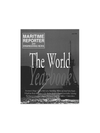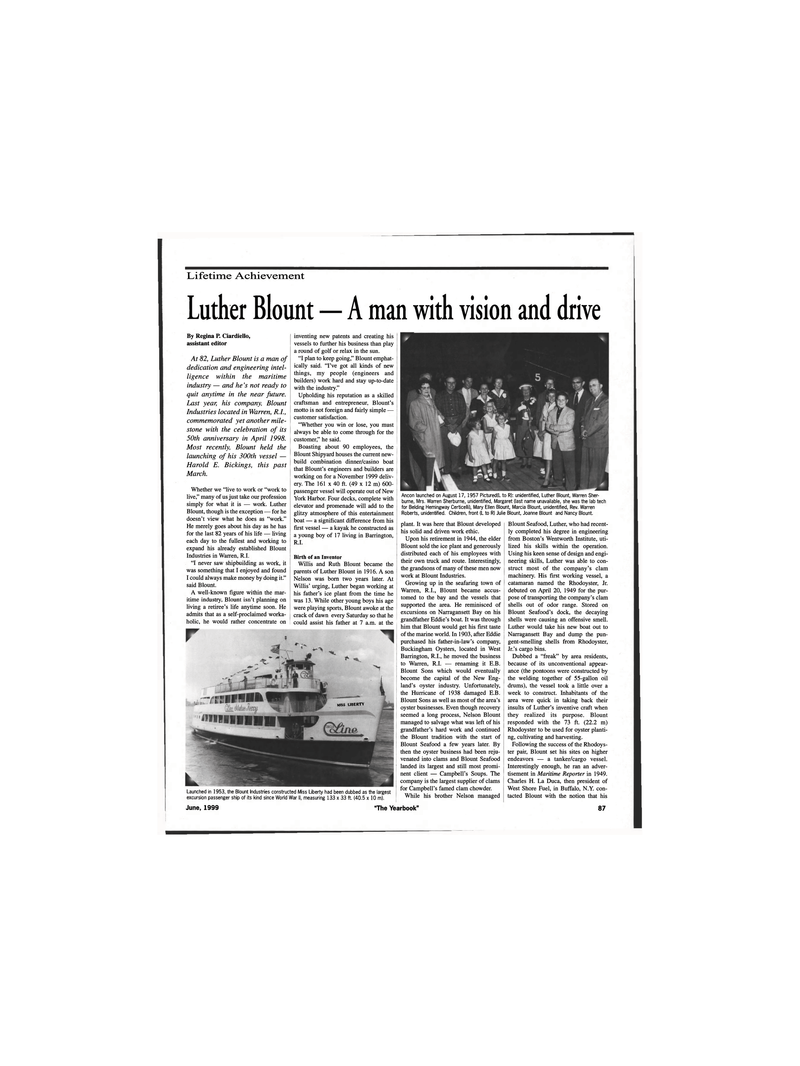
Page 85: of Maritime Reporter Magazine (June 1999)
Read this page in Pdf, Flash or Html5 edition of June 1999 Maritime Reporter Magazine
Lifetime Achievement
Luther Blount — A man with vision and drive
June, 1999 "The Yearbook" 87
By Regina P. Ciardiello, assistant editor
At 82, Luther Blount is a man of dedication and engineering intel- ligence within the maritime industry — and he's not ready to quit anytime in the near future.
Last year, his company, Blount
Industries located in Warren, R.I., commemorated yet another mile- stone with the celebration of its 50th anniversary in April 1998.
Most recently, Blount held the launching of his 300th vessel —
Harold E. Bickings, this past
March.
Whether we "live to work or "work to live," many of us just take our profession simply for what it is — work. Luther
Blount, though is the exception — for he doesn't view what he does as "work."
He merely goes about his day as he has for the last 82 years of his life — living each day to the fullest and working to expand his already established Blount
Industries in Warren, R.I. "I never saw shipbuilding as work, it was something that I enjoyed and found
I could always make money by doing it." said Blount.
A well-known figure within the mar- itime industry, Blount isn't planning on living a retiree's life anytime soon. He admits that as a self-proclaimed worka- holic, he would rather concentrate on inventing new patents and creating his vessels to further his business than play a round of golf or relax in the sun. "I plan to keep going," Blount emphat- ically said. "I've got all kinds of new things, my people (engineers and builders) work hard and stay up-to-date with the industry."
Upholding his reputation as a skilled craftsman and entrepreneur, Blount's motto is not foreign and fairly simple — customer satisfaction. "Whether you win or lose, you must always be able to come through for the customer," he said.
Boasting about 90 employees, the
Blount Shipyard houses the current new- build combination dinner/casino boat that Blount's engineers and builders are working on for a November 1999 deliv- ery. The 161 x 40 ft. (49 x 12 m) 600- passenger vessel will operate out of New
York Harbor. Four decks, complete with elevator and promenade will add to the glitzy atmosphere of this entertainment boat — a significant difference from his first vessel — a kayak he constructed as a young boy of 17 living in Barrington,
R.I.
Birth of an Inventor
Willis and Ruth Blount became the parents of Luther Blount in 1916. A son
Nelson was born two years later. At
Willis' urging, Luther began working at his father's ice plant from the time he was 13. While other young boys his age were playing sports, Blount awoke at the crack of dawn every Saturday so that he could assist his father at 7 a.m. at the
Launched in 1953, the Blount Industries constructed Miss Liberty had been dubbed as the largest excursion passenger ship of its kind since World War II, measuring 133 x 33 ft. (40.5 x 10 m).
Ancon launched on August 17, 1957 Pictured! to R): unidentified, Luther Blount, Warren Sher- burne, Mrs. Warren Sherburne, unidentified, Margaret (last name unavailable, she was the lab tech for Belding Hemingway Certicelli), Mary Ellen Blount, Marcia Blount, unidentified, Rev. Warren
Roberts, unidentified. Children, front (L to R) Julie Blount, Joanne Blount and Nancy Blount. plant. It was here that Blount developed his solid and driven work ethic.
Upon his retirement in 1944, the elder
Blount sold the ice plant and generously distributed each of his employees with their own truck and route. Interestingly, the grandsons of many of these men now work at Blount Industries.
Growing up in the seafaring town of
Warren, R.I., Blount became accus- tomed to the bay and the vessels that supported the area. He reminisced of excursions on Narragansett Bay on his grandfather Eddie's boat. It was through him that Blount would get his first taste of the marine world. In 1903, after Eddie purchased his father-in-law's company,
Buckingham Oysters, located in West
Barrington, R.I., he moved the business to Warren, R.I. — renaming it E.B.
Blount Sons which would eventually become the capital of the New Eng- land's oyster industry. Unfortunately, the Hurricane of 1938 damaged E.B.
Blount Sons as well as most of the area's oyster businesses. Even though recovery seemed a long process, Nelson Blount managed to salvage what was left of his grandfather's hard work and continued the Blount tradition with the start of
Blount Seafood a few years later. By then the oyster business had been reju- venated into clams and Blount Seafood landed its largest and still most promi- nent client — Campbell's Soups. The company is the largest supplier of clams for Campbell's famed clam chowder.
While his brother Nelson managed
Blount Seafood, Luther, who had recent- ly completed his degree in engineering from Boston's Wentworth Institute, uti- lized his skills within the operation.
Using his keen sense of design and engi- neering skills, Luther was able to con- struct most of the company's clam machinery. His first working vessel, a catamaran named the Rhodoyster, Jr. debuted on April 20, 1949 for the pur- pose of transporting the company's clam shells out of odor range. Stored on
Blount Seafood's dock, the decaying shells were causing an offensive smell.
Luther would take his new boat out to
Narragansett Bay and dump the pun- gent-smelling shells from Rhodoyster,
Jr.'s cargo bins.
Dubbed a "freak" by area residents, because of its unconventional appear- ance (the pontoons were constructed by the welding together of 55-gallon oil drums), the vessel took a little over a week to construct. Inhabitants of the area were quick in taking back their insults of Luther's inventive craft when they realized its purpose. Blount responded with the 73 ft. (22.2 m)
Rhodoyster to be used for oyster planti- ng, cultivating and harvesting.
Following the success of the Rhodoys- ter pair, Blount set his sites on higher endeavors — a tanker/cargo vessel.
Interestingly enough, he ran an adver- tisement in Maritime Reporter in 1949.
Charles H. La Duca, then president of
West Shore Fuel, in Buffalo, N.Y. con- tacted Blount with the notion that his
MISS LIBERTY

 84
84

 86
86
